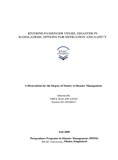Riverine passenger vessel disaster in Bangladesh : options for mitigation and safety

View/Open
Date
2009-09Publisher
BRAC UniversityAuthor
Azad, Abul KalamMetadata
Show full item recordAbstract
Bangladesh is a riverine country and waterways are very important means of communication in this region. Since long, traditionally river network has been regarded as safe and cost-effective route especially in the southern part of Bangladesh. Every year around 87.80 million passengers are carried through this route (Bangladesh Inland Water Transport Authority). This important mode of transport is ridden with tragic disasters every year, incurring a heavy toll of human lives. Around 3,869 people have died and 279 gone missing in 458 launch disasters since 1976 (Department of Shipping). The in land routes of Barisal, Bhola, Chandpur and Patuakhali and their connected water ways to Dhaka and Chittagong are found to be more accident prone. Boundless operation of unfit vessels, overloading of passenger, recruitment of unskilled crews, poor capacity of relevant government bodies and low standard maintenance of Inland Water Transport (IWT) channels are initiating these deadly accidents. The government's weakness in enforcing laws, mismanagement, negligence and irresponsibility of concern authorities, profit centred attitude of vessel owners, corruption and insufficient budget are the underlying causes of these tragic disasters. The unlimited death causing accidents definitely has a negative impact on this promising sector of transportation. Government is to take immediate measures for establishing risk free riverine transport systems and eradicating irregularities and corruption from this sector for proving sincerity and pro-poor stance. This study is an attempt to identify different factors that causing passenger vessel fatalities and thereby addressing viable options for Bangladesh.
